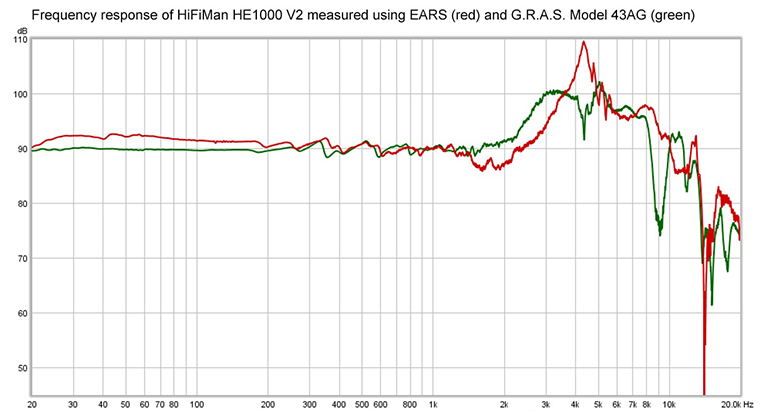Initial results from the MiniDSP EARS with my headphones: 2 pair of 20-year old HD-580, and 1 pair Audeze LCD-2F with 2016 drivers. The HD-580s both have relatively fresh pads, though one is more fresh than the other.
On the MiniDSP EARS: the interaural distance is 13cm which is smaller than most adults. The ears are made of rubbery compliant silicone. Not as anatomically correct as a GRAS or similar device, but better than a simple flat plane mic. For those using it, the user manual and mic correction curves are free downloads from the MiniDSP web site. They offer 4 different calibration files for each mic (L and R):
- HEQ - they recommend using this for EQ. Is "H" for "Harman"?
- HPN - they recommend using this for comparison with professional measurements.
- IDF - for use with IEMs (the HRTF for IEMs is different than for headphones)
- RAW - correct for mic response only, no HRTF correction
I used the HEQ calibration curves. DIP switches in the center set the mic gain (default -18 dB). It plugs into a computer's USB and appears to the system as a stereo microphone. On my Ubuntu 18 system it was plug & play, no drivers needed. It works seamlessly with Room EQ Wizard. I measured each headphone at least 3 times, completely removing it from the stand and reinstalling it for each. Most of the time, the differences were never more than 1 dB, which surprised me (I expected bigger variations).
The measurements look mostly yet not entirely reasonable. Take the accuracy of the measurements with a grain of salt for a few reasons. The CSD plots, because I've never seen anything that clean and the decay time doesn't rise in the low frequencies as much as I normally see in professional measurements. The HD-580 showed a deep null at 5.8-6.0 kHz which I've never seen before in any other measurement, and it's not a fluke as it appeared on both of my units, consistently every time I measured, and this null did not appear on the LCD-2F. This null was like a black hole resistant to EQ: no amount of extra energy I added made any difference. All that said, here are my initial measurements:
Here are some plots for the two HD-580 headphones. Each individually was very consistent, but they measured differently from each other. They do stay within about 2 dB of each other. I suspect most of these differences are due to the pads on one being more fresh than the other.
Distortion: as expected for HD-580, but the 4.5 kHz spike is unexpected, just touching 1% / -40 dB.
This looks too good to be true, as the HD-580s impedance and phase has much bigger swings than this.
You can see the step response falls off quickly due to the lack of low frequency response.
This CSD looks suspiciously clean, especially in the low frequencies. Yet on second look it does rise in the lows relatively speaking as the top is dropping off. At 20 Hz the difference from top to blue is 40 dB (15 to 55) while at 1 kHz it's at least 65. The 120 Hz blip is probably my computer fan.
Spectral decay is just a different view of the same thing, also suspiciously flat.
Now for the LCD-2F
FR measured 3 ways: Blue: no EQ. Green: with 2 bands of gentle parametric EQ. Red: with the JDS Subjective 3, turning down the midrange knob. Based on the FR curve, here's how I set the parametric EQ:
- 80 Hz, low shelf, +3 dB, Q=1.0
- 3350 Hz, bell, +6 dB, Q=0.7
I picked 3350 because the dip ranges from 1.4 to 8 kHz. The geometric center is 3346 with a ratio of 2.39:1 on each side. The graph says to bump it about 8 dB but subjectively that sounded too bright, a 6 dB correction sounds about right. The graph is a useful guide but don't worship it. Everyone's HRTF varies from the standard.
Distortion: a relatively flat 0.2% (-50 to -55 dB) across the board even in the bass, as expected for the Audeze LCD series. The noise spike at 120 Hz and below 50 Hz is fan noise from my PC. Again we see a little spike at 4.5 kHz just like with the HD-580, maybe that is the EARS microphone?
Group delay: flat as expected for a planar (flat impedance & phase vs. frequency).
Impulse looks decent with sustained step response, likely due to extended LF response.
CSD is suspiciously clean, same as with the HD-580. Doesn't look quite as clean as the HD-580, but this is misleading as the top line is flat. They're actually similar. At 20 Hz, top to blue is 45-50 dB and at 1 kHz it's about 70 dB (7 to 77). Again, the 120 Hz blip is probably my computer fan which also appeared in the distortion plot.
Nothing much to see here, just a different view of the CSD.
Overall, the MiniDSP EARS is easy to use and seamlessly integrates with Room EQ Wizard. Even if its measurements are limited by the simple nature of this device, you can at least see if your headphones are working right and get some directional idea about frequency response and distortion. And that's all you really need for EQ, as it is an inexact science. Don't try to correct every nitnoid wiggle, but just correct the major deviations.
Any tips or suggestions, LMK. I've got this for a little while longer and I can try other stuff. I might measure the VSONIC VSD1S IEMs that I use when traveling.

